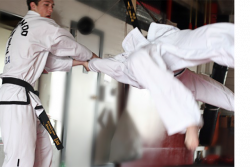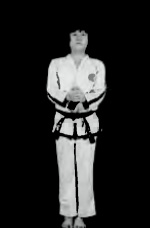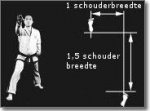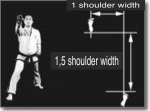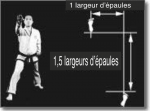Student Booklet - 3rd KUP exam (Blue belt / Red tag)
Student booklet /
Main Menu
Student Booklet - 3rd KUP exam (Blue belt / Red tag)
Exam 3rd Kup
Student booklet
Joong-Gun - Contexte historique (TAEKWONDO YOKSA) pour examen 3ème KUP
"JOONG-GUN" est le nom du patriote Ahn Joog-Gun qui assassina Hiro Bumi Ito, le 1er Gouverneur- Général Japonais en Corée. Les 32 mouvements représentent l’âge de Ahn lorsqu’il fut exécuté à la prison de Lui-Shung en 1910.
Fin du tul (attendre l’instruction) : ramener le pied gauche en MOA SOGI B
Retour en haut de la page - Menu principal
Joong-Gun Historical background (TAEKWONDO YOKSA) for 3rd KUP exam
"JOONG-GUN" is named in reference to the patriot AHN JOONG-GUN who murdered Hiro Bumi Ito (the (the first Japanese governor-general of Korea).
The 32 movements of the Tul represents the age of Ahn when he was executed in Lui-Shung prison (1910).
End: Bring the left foot to MOA SOGI B
Back to top of page - Back to Welcome Page
Joong-Gun Historische achtergrond (TAEKWON-DO YOKSA) voor de 3de kup examen
"JOONG-GUN" “JOONG-GUN” is genaamd naar de patriot AHN JOONG-GUN die Hiro Bumi Ito (die eerste Japanse gouverneur-generaal van Korea was ) vermoorde. De 32 bewegingen van de Tul slaan op de leeftijd van Ahn toen hij geëxecuteerd werd in de Lui-Shung gevangenis (1910).
Einde: Breng de linkervoet naar MOA SOGI B
Terug naar top van pageina - Hoofd menu
Connaissance du Taekwondo pour la 3ème KUP
Retour en haut de la page - Menu principal
Matsogi
Pour l’examen, l’étudiant doit présenter 10 Sambo Matsugi’s (3-step sparring), 10 Ibo Matsugi’s (two-step sparring) et 8 Ilbo Matsugi’s (one-step sparing).
Pour vous raffraîchir la mémoire, cliquez ici.
Hosinsul
Foreword
En Hosinsul (self-defense), il y a principalement un contact physique entre l’attaquant et le défenseur. En cas de défense contre des armes, il y a principalement contact physique du défenseur contre l’attaquant.
On traite le Hosinsul en deux blocs :
- contact physique d’un attaquant
- attaque avec armes
C’est pourquoi le Taekwondo est un sport moderne vu toutes les possibilités et techniques de défense. Défense à grande distance avec les jambes, mi-distance (bras, coudes, genoux) ou courte distance (jet, techniques de libération, points vitaux).
Note: il est toujours possible de se retrouver face à un adversaire très fort. Les solutions sont :
- utiliser votre vitesse et des mouvements en rotation
- toucher l’assaillant à des points qui font mal
Contact physique d’un attaquant
L’attaquant vous agrippe ; trois possibilités :
- mouvement offensif : contre-attaquer avec un coup sur un point vital ou vulnérable
- mouvement de casse sur le corps de l'assaillant
- mouvement de libération par un mouvement rotatif suivi d’une contre-attaque
Situation d’attaque
- Debout
- A genoux
- Couché
- Attaque surprise de l’assaillant
Retour en haut de la page - Menu principal
Techniques de lancer et de chute
Chuter est un art, retenez ces principes :
- Relâcher votre corps
- Essayer de tomber sur le côté et non de face ou de dos
- Absorber le choc avec la paume de la main sur le sol
- Baisser la tête vers la poitrine pour éviter de tomber sur l'arrière de la tête
- Jambes vers le haut
N'amenez votre assaillant au sol que si vous ne voulez pas le blesser.
Principe : retirer l’équilibre de l’assaillant:
- Debout
- A genoux
- Couché
Attaque avec armes
Vous êtres attaqué avec une arme. Esquiver est le plus approprié mais vous n’êtes pas assez loin (contre-attaque possible ou saisie de l’arme).
Essayer de laisser l’assaillant faire un pas de plus, ceci pour être suffisamment proche et préparer la contre-attaque.
PIHAGI (esquiver) est important. Gauche ou droite, mais pas en arrière.
Vous pouvez faire un bloc contre le bras ou la main, mais pas contre l’arme.
Possibilités : contre un couteau, une baillonnette, un bâton, un long bâton
Kennis van Taekwondo voor de 3de KUP
Kennis /
Main Menu
Student Booklet - 3rd KUP exam (Blue belt / Red tag)
Examen 3de Kup
Document containing source information
</noinclude>
Matsogi
Voor het examen moet de student 10 sambo matsugi’s uitvoeren. Daarnaast moet de student 10 ibo matsugi's (tweestaps) demonstreren. Op het examen zal de student ook 8 ilbo-matsugi's (eenstapsparring) uit moeten voeren.
Hosinsul
Voorwoord
Bij HOSINSUL (= self- defence) is er meestal fysisch contact tussen de aanvaller naar verdediger. Bij verdediging tegen wapens is er meestal fysisch contact van de verdediger tegen de aanvaller. We delen hosinsul op in twee blokken:
- Fysisch contact aanvaller
- Aanvaller met wapens
Daarom is ITF taekwondo een moderne sport gezien van alle mogelijke verdedigingstechnieken. Voor verdediging op bijvoorbeeld lange afstand (benen), middellange afstand (armen, elleboog, knie) of dichte afstand (werpen, bevrijdingstechnieken, vitale punten).
Noot
Het is steeds mogelijk dat men geconfronteerd wordt met een zeer sterke tegenstrever. Hier zijn twee oplossingen:
- gebruik uw snelheid en draaiende beweging.
- raak de tegenstrever op een pijnlijke plaats.
Fysisch contact aanvaller
De tegenstrever houdt u vast. Drie mogelijkheden:
- Aanvallende beweging: tegenstrever tegenaanvallen met slag of stamp op een vitale plaats of kwetsbaar lichaamsgedeelte.
- Brekende beweging: op het aanvallende lichaamsdeel.
- Bevrijdende beweging: door draaiende beweging, gevolgd door tegenaanval.
Aanvalsituaties
- Rechtstaand
- Geknield
- Liggend
- Plotse aanval van tegenstrever
Werp- en valtechnieken
Vallen is een kunst, houd rekening met deze regels.
- Ontspan het lichaam
- Probeer te vallen op u zijde en niet frontaal op de rug.
- Absorbeer de schok door te slaan met de palm van de hand op de grond.
- Kin intrekken naar borst om te vermijden op het achterhoofd te vallen.
- Benen hoog.
Alleen werpen van tegenstander op de grond wanneer u hem niet erg wil kwetsen. Grondprincipe: tegenstrever uit evenwicht. Mogelijkheden:
- Rechtstaand
- Geknield
- Liggend
Aanvaller met wapens
U wordt aangevallen met wapen(s). Uitwijken is het meest aangewezen maar je staat niet ver genoeg (tegenaanval mogelijk of wapen vastnemen). Probeer de tegenstrever een extra “stap” te laten maken. Om dan zo dicht (of gunstig) mogelijk voor de tegenaanval klaar te staan. Pihagi (=uitwijken) is belangrijk. Naar links of rechts, maar niet naar achter in één lijn. Blok tegen de arm of het hand, maar niet tegen het wapen. Mogelijkheden:
- Tegen een dolk. (alle richtingen)
- Tegen een bajonet. (=lang wapen)
- Tegen een stok.
- Tegen een lange stok (biljartstok,…)
Terug naar top van deze pagina - Terug naar de welkom pagina
Knowledge of Taekwondo for 3rd KUP
Matsogi
For the exam, the student must perform 10 SAMBO MATSOGI programs. In addition, the student's needs 10 IBO MATSOGI (two-step) demonstration. During the exam, the student will also perform 8-ILBO MATSOGI's (one step sparing).
Should you need a reminder on how to proceed, see this link.
Hosinsul
Foreword
In HOSINSUL (self-defense), there usually is a physical contact between the attacker to defender.
In defense against weapons there usually is a physical contact of the defender against the attacker.
We divide hosinsul into two parts:
- Physical contact attacker
- Forward with weapons
Therefore, ITF Taekwondo is a modern sport considering all possible defense techniques such as long distance (legs), medium range (arms, elbow, knee) or close combat (throwing, extrication, vital points).
Note: It is always possible that one is faced with a very strong opponent. Here are two solutions:
- Use your speed and a rotational movement.
- Hit the opponent on a painful place.
Physical contact attacker
The opponent holds.
Three possibilities:
- Offensive movement: attacks with stroke or stamp on a vital place or vulnerable body spot.
- Breaking movement: on the attacking limb.
- Liberation movement: a twisting motion followed by counterattack.
Attack Situations
- standing
- kneeling
- lying
- sudden attack of opponent
Back to top of page - Back to Welcome Page
Throwing and falling techniques
Falling is an art, take into account these rules :
- Relax Body
- Try to fall on your side, not your front or back.
- Safely absorb the shock with the palm of the hand on the ground.
- avoid hitting the head.
- Legs high.
Don’t just throw your opponent to the ground during training, you do not want to hurt him.
Ground Principle: make opponent off balance. Possibilities:
- Standing
- Kneeling
- Lying
Attacker with weapons
You are attacked with a weapon (s). Dodging is the most appropriate move, but you're not safe enough.
Try to let the opponent make an additional "step". To be so close to him (or to the weapon according to your placement) makes it easier to finish your counterattack.
Pihagi (= evade, avoid) is important. Left or right, but not back in line. Block against the arm or hand, but not against the weapon (don’t touch the weapon when blocking, especially when blocking knives).
Back to top of page - Back to Welcome Page
Hand-Technieken voor 3de KUP
| Koreaan | Nederlands |
|---|---|
| SONKAL DUNG KAUNDE BAKURO MAKGI | meshand omgekeerde buitenwaartse verdediging (1bew Joong-Gun) |
| SONDABAK BANDAE OLLYO MAKGI | handpalm opwaartse verdediging (3de bew Joong-Gun) |
| WI PALKUP TAERIGI | opwaartse elleboogslag (elleboog Joong-Gun) |
| SANG JOOMUK NOPUNDE SEWO JIRUGI | hoge tweeling verticale vuiststoot (11de bew Joong-Gun) |
| SANG JOOMUK DWIJIBUN JIRUGI | tweeling omgekeerde vuiststoot (12de bew Joong-Gun) |
| KYOCHA JOOMUK CHOOKYO MAKGI | X-vuist opwaartse verdediging (13de bew Joong-Gun) |
| DOO PALMOK NOPUNDE MAKGI | hoge dubbel voorarm verdediging |
| SONDABAK BANDAE NOOLLO MAKGI | Phandpalm drukkende verdediging (27ste bew Joong-Gun) |
| KYOCHA JIRUGI | hoekstoot (30ste bew Joong-Gun) |
| DIGUTJA MAKGI | stokverdediging (31ste bew Joong-Gun) |
Terug naar top van deze pagina - Terug naar de welkom pagina
Hand-Technique for 3rd KUP
| Korean | English |
|---|---|
| SONKAL DUNG KAUNDE BAKURO MAKGI | Reverse knife-hand middle reverse block |
| SONDABAK BANDAE OLLYO MAKGI | Palm upward block |
| WI PALKUP TAERIGI | Upper elbow strike |
| SANG JOOMUK NOPUNDE SEWO JIRUGI | Twin fist high vertical punch |
| SANG JOOMUK DWIJIBO JIRUGI | Twin fist upset punch |
| KYOCHA JOOMUK CHOOKYO MAKGI | X-fist rising block |
| DOO PALMOK NOPUNDE MAKGI | Double forearm block |
| SONDABAK BANDAE NOOLLO MAKGI | Palm pressing block |
| KYOCHA JIRUGI | Front forefist angle punch |
| DIGUTJA MAKGI | U-shape block |
Back to top of page - Back to Welcome Page
Techniques de main pour la 3ème KUP
| Coréen | Français |
|---|---|
| SONKAL DUNG KAUNDE BAKURO MAKGI | Bloc intérieur du tranchant de la main (1er mouvement Joong-Gun) |
| SONDABAK BANDAE OLLYO MAKGI | Bloc en cercle de la paume (3ème mouvement de Joong-Gun) |
| WI PALKUP TAERIGI | Coup de coude vers le haut |
| SANG JOOMUK NOPUNDE SEWO JIRUGI | Double coup de poing vertical (11ème mouvement de Joong-Gun) |
| SANG JOOMUK DWIJIBO JIRUGI | Double coup de poing inversé |
| KYOCHA JOOMUK CHOOKYO MAKGI | Bloc croisé haut (13ème mouvement de Joong-Gun) |
| DOO PALMOK NOPUNDE MAKGI | Double blocage haut des avant-bras |
| SONDABAK BANDAE NOOLLO MAKGI | Bloc en cercle de la paume (27ème mouvement de Joong-Gun) |
| KYOCHA JIRUGI | Coup de poing angulaire (30ème mouvement de Joong-Gun) |
| DIGUTJA MAKGI | Défense en U (31ème mouvement de Joong-Gun) |
Retour en haut de la page - Menu principal
DWITBAL SOGI - Achtervoet stand
Deze stand wordt voornamelijk voor de verdediging gebruikt, maar soms ook voor de aanval.
Het grote voordeel van deze stand is dat er zonder verplaatsing van het lichaamsgewicht overgegaan kan worden tot het aanvallen met een trap of het verplaatsen van het lichaam.
De stand wordt altijd uitgevoerd met een halfaangezicht. Zorg ervoor dat de knie van het achterste been ligt naar binnen wijst.
- Beweeg een van beide voeten naar voren of naar achteren, zodat er een afstand van één schouderbreedte tussen beide tenen ontstaat.
- Buig het achterste been zover zodat de knie over de tenen komt. Plaats daabij de hiel net achter de hiel van de voorste voet.
- Buig het voorste been en bewaar licht contact met de bal van de voet van het voorste been.
- Zorg ervoor dat de tenen van de voorste voet ongeveer 25 graden en de tenen van de achterste voet ongeveer 15 graden naar binnen wijzen.
- Het lichaamsgewicht bevindt zich voornamelijk op het achterste been.
Terug naar top van deze pagina - Terug naar de welkom pagina
DWITBAL SOGI - Position sur pied arrière
Cette position est utilisée principalement à la défense mais parfois aussi pour l’attaque.
Le grand avantage de cette position est que l’on peut attaquer avec un coup de pied sans déplacement du poids du corps.
Cette position est toujours exécutée à moitié de face. Assurez-vous que le genou de la jambe arrière soit orienté vers l’intérieur.
- Bougez un des deux pieds vers l’avant ou l’arrière, de manière à avoir une distance d’épaule entre les deux.
- Pliez la jambe arrière pour que le genou soit en ligne avec les orteils. Placez le talon arrière derrière le talon du pied avant.
- Pliez la jambe avant et garder un contact léger au sol avec la plante du pied.
- Assurez-vous que les orteils du pied avant soient à environ 25° et les arrières à 15° vers l’intérieur.
- Le poids du corps se trouve sur la jambe arrière.
Retour en haut de la page - Menu principal
DWITBAL SOGI - Rear Foot Stance
This mode is mainly used for defense, but sometimes also for the attack.
The great advantage of this mode is that it can be passed to attacks with a kick without displacement of the body weight. The position is always performed with a side facing.
Make sure the knee of the back leg is pointing inwards.
- Move either foot forward or backward, so that a distance of one shoulder width arises between the two toes.
- Bend the back leg so far as the knee is over the toes. Place the bck heel just behind the heel of the front foot.
- Bend the front leg and keep light contact with the ball of the foot of the front leg.
- M Make sure the toes of the front foot are facing about 25 degrees inward and the toes of the back foot are facing approximately 15 degrees inward.
- The body weight is primarily on the back leg.
- Move either foot forward or backward, so that a distance of one shoulder width arises between the two toes.
Back to top of page - Back to Welcome Page
MOA SOGI B - Closed Stance
A position held with the feet down together. Possibly executable with full facing or a side facing.
Some of the 24 patterns, starting with this position.
Back to top of page - Back to Welcome Page
MOA SOGI B - Position fermée
C’est une position dans laquelle les pieds sont joints.
Elle peut être exécutée entièrement de face ou de côté.
Beaucoup des 24 formes (Tuls) commencent avec cette position.
Retour en haut de la page - Menu principal
NACHUO SOGI - Lage stand
Het voordeel van deze stand is het gemak waarmee het aanvallende ledemaat kan worden uitgestrekt.
De stand draagt ook bij aan de ontwikkeling van de beenspieren en maakt het goed mogelijk de afstand tot de tegenstander aan te passen.
De stand is gelijk aan een loopstand, alleen dan langer.
De stand mogelijk uitvoerbaar met een vol aangezicht of een zijaangezicht.
Terug naar top van deze pagina - Terug naar de welkom pagina
NACHUO SOGI - Low stance
The advantage of this stance is the ease with which one can extend the attacking tool.
It can also develop the leg muscles and is effective to adjust the distance to and from the target.
It is similar to the walking stance, though longer by one foot. It can be either full facing or side facing.
Back to top of page - Back to Welcome Page
NACHUO SOGI - Position longue
L’avantage de cette position est que le membre qui attaque peut facilement être étiré.
Cette position contribue également au développement des muscles de la jambe et permet de régler la distance jusqu’à l’adversaire.
Elle est identique à la position de marche, juste plus longue.
Elle peut être exécutée entièrement de face ou à moitié de face.
Retour en haut de la page - Menu principal
Examen naar 3de kup - Blauwe gordel rode streepje
- Al de kennis van de vorige examens
- Betekenis van "Joong-Gun"
- Nieuwe technieken te weten, tonen, en te kunnen verklaren
- Sinusgolf (sinewave) soorten bewegingen noemen en uit te leggen
- Goed uitvoeren "Chon-Ji" tul
- Goed uitvoeren "Dan-Gun" tul
- Goed uitvoeren "Do-San" tul
- Goed uitvoeren "Won-Hyo" Tul
- Goed uitvoeren "Yul-Gok" Tul
- Goed uitvoeren 12 verschillende Sambo Matsugi's (three step sparring)
- Goed uitvoeren 10 verschillende Ibo Matsugi's (two step sparring)
- Goed uitvoeren 8 verschillende Ilbo Matsugi's (one step sparring)
- 2 minuten met een partner kunnen vechten om de verschillende geleerde technieken te demonstreren.
- Break test : 2 breektechnieken die op een houten plank of herbruikbare plank worden uitgevoerd
- YOP CHAGI
- SONKAL DUNG TAERIGI
Terug naar boven - Hoofd pagina
Grading to the 3rd Kup (Blue Belt - Red Tag)
- All the previous knowledge that you had to learn.
- Meaning of "Joong-Gun"
- New techniques to know, being able to show and explain
- Types of sine wave motions, being able to enumerate and explain
- Correctly perform "Chon-Ji" tul
- Correctly perform "Dan-Gun" tul
- Correctly perform "Do-San" tul
- Correctly perform "Won-Hyo" tul
- Correctly perform "Yul-Gok" tul
- Correctly perform 12 different Sambo Matsugi's (three step sparring)
- Correctly perform 10 different Ibo Matsugi's (two step sparring)
- Correctly perform 8 different Ilbo Matsugi's (one step sparring)
- 2 min fight with a partner for the purpose to demonstrate different learned techniques during a fight
- 10 practical hosinsul techniques to perform with partner
- Break test : 2 breaking techniques performing on wooden shelf of reusable shelf
- YOP CHAGI
- SONKAL DUNG TAERIGI
Back to top of page - Back to Welcome Page
Requis examen 3eme Kup (ceinture bleue-barrette rouge)
- Toute la théorie des niveaux précédents
- La signification de Joong-Gun
- Pouvoir montrer toutes les nouvelles techniques apprises et les expliquer
- Les type de "sine wave" et les expliquer
- Exécuter correctement Chon-Ji
- Exécuter correctement Dan-Gun
- Exécuter correctement Do-San
- Exécuter correctement Won-Hyo
- Exécuter correctement Yul-Gok
- Exécuter correctement Joong-Gun
- Exécuter correctement 12 Sambo Matsogi's (three step sparring)
- Exécuter correctement 12 Ibo Matsogi's (two step sparring)
- Exécuter correctement 12 Ilbo Matsogi's (one step sparring)
- Pouvoir combattre avec un partenaire durant 2 minutes pour montrer les techniques apprises.
Casse de planche - 2 techniques : YOP CHAGI & SONKAL DUNG TAERIGI
